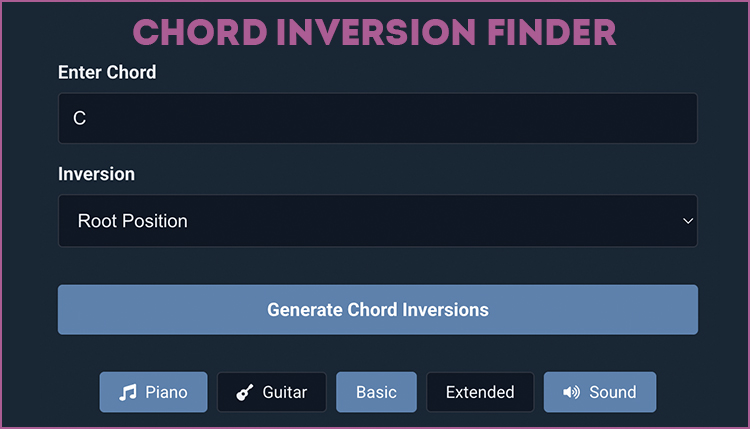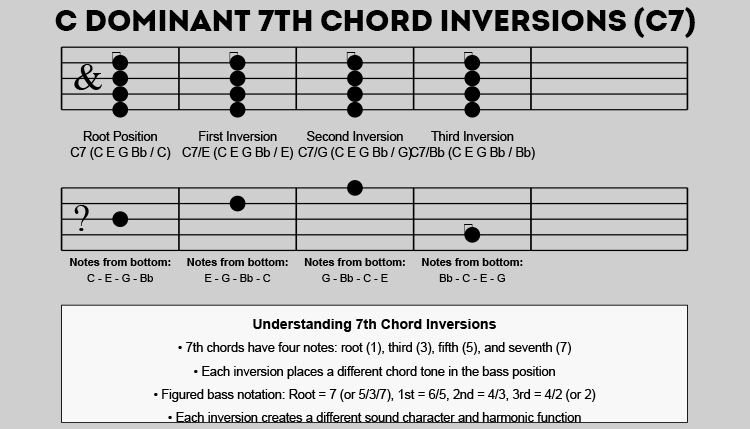Table of Contents
What Are Chord Inversions?
Let’s start with something simple: a chord inversion is just a chord with a different note in the bass. That’s it.
But don’t let the simplicity fool you — these little changes can flip the whole vibe of your song.
In a root position chord, the root (the note the chord is named after) is the lowest note.
For example, in a C major chord (C-E-G), the C is on the bottom.
Now, if you move the C to the top and leave E or G in the bass, that’s an inversion.
It’s still a C major chord — just flipped around a bit.
Here’s the breakdown:
- Root position: Root is in the bass. (C-E-G)
- 1st inversion: The third is in the bass. (E-G-C)
- 2nd inversion: The fifth is in the bass. (G-C-E)
It gets a little more involved with 7th chords, but the idea’s the same — just rotating which note is on the bottom.
Each inversion gives the chord a slightly different flavor, even though the notes stay the same.
So why should you care? Because using inversions is like learning to season your food. Anyone can cook pasta, but only some folks can make it taste like magic.
Inversions are that secret sauce for your songwriting, arranging, or playing.
Oh — and side note — inversions aren’t just for theory nerds or classical musicians. You hear them in everything from indie rock to gospel to film scores.
If your music sounds choppy or stiff, learning inversions might just be your fix.
Let’s dig into why these things are more important than you think.
Why Every Musician Should Care
If you’ve ever felt like your chord progressions sound clunky, robotic, or just too obvious, chord inversions can smooth out those rough edges.
Seriously — they’re a game-changer. And yet, tons of musicians overlook them.
Here’s what they do for you:
- Cleaner transitions: Instead of jumping all over your instrument, you can keep notes closer together.
- Bass line control: You can guide your bassline better and create emotional movement without changing the chord.
- More interesting voicings: Even simple chords can sound lush and layered.
- Less repetition: You can repeat the same chord and make it sound fresh just by inverting it.
Let’s say you’re playing C – F – G on piano. In root positions, you’re hopping around a lot.
But if you throw in some inversions, those jumps become smooth slides.
The chord still functions the same, but the journey there feels a whole lot better. Your hands — and your listeners — will thank you.
Guitarists? Same deal. Chord inversions let you stay in a position and play alternate bass notes that feel way more intentional.
It’s especially helpful when you’re playing with a bassist or another guitarist. You stay out of each other’s way but still build a bigger sound together.
And if you’re a producer or songwriter, it’s all about texture.
Ever heard a song where the chords don’t change, but the vibe totally shifts?
Inversions. That’s the trick. They let you recycle harmony in new ways without feeling stale. It’s music theory you can actually use.
Don’t be the musician who skips this step. You’re leaving so much color on the table.
How to Use the Chord Inversion Finder
This is where it gets fun. The Chord Inversion Finder is built to make your life easier, whether you’re noodling around, writing a hit, or arranging for your band.
Here’s how it works:
- Step 1: Enter your chord — like C major, D minor, G7, or even Amaj7.
- Step 2: Choose your instrument (piano or guitar).
- Step 3: View the chord’s inversions: Root, 1st inversion, 2nd inversion (and 3rd for 7th chords).
- Step 4: Click to hear each one. The audio helps you feel the difference instantly.
- Step 5: Check out the visual diagram — whether it’s a virtual piano, keyboard or guitar fretboard, you’ll see how to play it.
But that’s not all. The tool also shows you how these inversions affect the bassline, where the common tones are, and even gives you voice leading tips.
Bonus: Check out a few practice tools, like these beginner friendly Piano Keyboards or these top acoustic guitars.
These tools that make practicing inversions easier and more fun.
The point is to stop guessing. With this tool, you can start applying inversions in your actual songs, not just your practice routine.
Understanding 7th Chord Inversions
The visualization shows the C dominant 7th chord (C7) in all possible positions. Unlike triads which have three positions, seventh chords have four positions (root position plus three inversions) because they contain four notes.
C Dominant 7th Chord (C7): C – E – G – Bb
- Root Position: The root note (C) is in the bass
- Notes from bottom to top: C – E – G – Bb
- Figured bass notation: 7 (or 5/3/7)
- First Inversion: The third of the chord (E) is in the bass
- Notes from bottom to top: E – G – Bb – C
- Figured bass notation: 6/5
- Second Inversion: The fifth of the chord (G) is in the bass
- Notes from bottom to top: G – Bb – C – E
- Figured bass notation: 4/3
- Third Inversion: The seventh of the chord (Bb) is in the bass
- Notes from bottom to top: Bb – C – E – G
- Figured bass notation: 4/2 (or simply 2)
Musical Function and Character
Each inversion creates a different sound color and serves different harmonic functions:
- Root Position: Most stable form of the chord
- First Inversion: Smoother bass motion, less stable than root position
- Second Inversion: Creates tension, often used in cadential progressions
- Third Inversion: Highest tension, strongly resolves to another chord (typically with the bass moving down by step)
Seventh chord inversions are particularly useful in jazz, creating smooth voice leading between chords and interesting bass lines. The third inversion is especially distinctive, with the dissonant seventh in the bass creating a strong need for resolution.
Real-World Examples: Pop, Jazz, Worship, EDM
Chord inversions aren’t stuck in music theory class — they live in your favorite songs.
From ballads to bangers, here’s how they show up:
Pop: Let’s start with something everyone knows.
In Adele’s “Someone Like You,” that emotional piano progression? Inversions.
They create a haunting, climbing motion while keeping the chords familiar.
Pop producers use this constantly — they invert chords to make verses mellow and choruses hit harder.
Jazz: In jazz, inversions are everywhere.
A ii-V-I progression might use root position in one pass, and then swap to 1st or 2nd inversions in the next for smoother transitions and more interesting voicings.
Jazz musicians practically breathe inversions. They call it voice leading — and it’s a big deal.
Worship: If you’ve played in a church band, you already know the vibe.
Worship music is all about emotional build-ups and smooth flows.
Using inversions in C – G – Am – F progressions (or any variant) lets keyboardists and guitarists stay in one area of their instrument while creating dynamic shifts.
It’s powerful without being dramatic.
EDM: Yeah, even dance tracks use inversions.
Pads, leads, and arps often rely on inversions to keep motion going while the harmony stays steady.
It’s subtle but keeps the energy moving. You might not see it written out in a DAW, but the MIDI notes tell the story.
Use the Chord Inversion Finder to match the sound of your favorite genre.
Experiment with layering — maybe the piano plays the root position while the pad plays an inversion.
That’s layering with purpose. And it’s how the pros do it.
Here’s the real kicker: once you recognize inversions in songs you love, you’ll start hearing them everywhere.
Then you’ll start using them. And your music will instantly sound more polished.
Try the Chord Inversion Finder
Ready to mess around with it yourself? The Chord Inversion Finder is right here on the page.
Go ahead, drop in a chord and flip through the inversions. Listen to the playback.
Compare the voicings. Try it on a song you’re working on right now.
And hey — if you’re looking to level up your skills, there are great learning platforms online.
This jazz piano inversion tutorial is gold if you’re into more advanced voicings.
The tool is free to use, and built for everyone — from bedroom producers to touring musicians.
So don’t just read about inversions. Play them. Hear them. Use them.
Conclusion
Chord inversions are one of those things that seem small but make a massive impact. They smooth transitions, tighten up arrangements, and add new color to old progressions.
Once you start using them, you’ll wonder how you ever played without them. And now, with the Chord Inversion Finder, there’s zero guesswork. You can see, hear, and apply inversions in real time.
Whether you’re building a song from scratch or tweaking a live set, it’s your go-to tool for dialing in that professional sound.
So take a few minutes, explore some chords, and try out different inversions. Customize the sound. Experiment. Find what works for your style. That’s where the magic happens — in those little shifts that make your music yours.
Frequently Asked Questions
What are chord inversions?
Chord inversions are variations of a chord where a note other than the root is played in the bass (lowest position). For example, instead of C being the lowest note in a C major chord, you could put E or G in the bass — that’s a chord inversion. The overall harmony remains the same, but the sound and feel change depending on which note is in the bass.
How do you write chord inversions?
To write a chord inversion, first determine the original chord (like C major: C-E-G). Then, shift the order of the notes so that a different chord tone becomes the lowest note. For example:
- Root position: C-E-G
- 1st inversion: E-G-C (E in the bass)
- 2nd inversion: G-C-E (G in the bass)
When writing them in lead sheets or chord symbols, you can use slash notation. For example: C/E means a C major chord with E in the bass (1st inversion), and C/G is the 2nd inversion.
How do chord inversions work?
Chord inversions work by changing the bass note of a chord, which alters how it sounds and feels without changing its harmonic identity. They help with smoother voice leading, tighter bass lines, and more interesting textures. Inversions are especially useful in making chord progressions flow more naturally and avoiding large jumps between chords.





